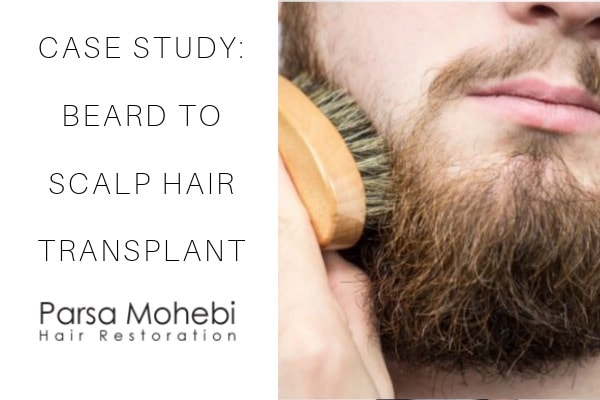Case Study: Beard-To-Scalp Hair Transplant

With the groundbreaking advancements in hair technology we have experienced, we can give patients hair restoration options that were never seen as possible. One of those procedures is the beard to scalp hair transplant.
Who needs a beard-to-scalp hair transplant?
For many patients that do not have an ideal amount of donor hair on the back of the scalp, hair transplant surgeons must look to other parts of the body to get high-quality donor grafts to transplant in the scalp. For men, the beard is the first option after the scalp for donor hair to transplant in the scalp. Beard hair is usually much thicker than donor hair from the back of the scalp and can give the hair shafts much more volume to the hair in the transplanted area after the transplant. It has also been reported that facial hair can be unwanted by men who have to shave their face on a daily basis, so they welcome the removal of the facial hair in the beard with open arms. Donor hair from other parts of the body (other than the beard) are typically used only as a last resort, and when we are sure that it is not sufficient. Here is a video explaining who is a good candidate for a body hair transplant:
Pros of Beard to Scalp Hair Transplant
- Scalp supply and demand mismatch – Almost anyone with this mismatch who has average or better than average beard hair could benefit from some extra hair that the scalp donor area cannot offer.
- Using the beard as donor hair helps the surgeon preserve donor hair on the traditional scalp safe zone for more critical areas such as frontal hairline, temporal points and eyebrows.
- Thicker hair shaft – Beard hair is usually much thicker than scalp hair which helps with creating more volume in transplanted areas. This thickness difference is very obvious in patients who have very fine scalp hair in which beard hair could be used as the main source to restore the balding areas of scalp.
- Facial hair is considered unwanted in many men who always shave their faces and removing it is considered a relief for them. Even men who grow a beard would like to remove the hair from under the chin or neck area. Many of our patients report that they spend less time shaving every day.
Cons of Beard to Scalp Hair Transplant
- Some men with sparse beard hair do not have sufficient beard hair that could be used as a donor source.
- The average number of hair follicles per follicular units or grafts is usually less than scalp donor grafts. Less hair per grafts equals less overall coverage. Beard hair per graft is usually closer to 1. This number is usually around 2 and more in scalp hair grafts.
- Although the coarse thickness of beard hair is beneficial to some patients who need more bulk, the coarse hair can be problematic in some areas where the hair is naturally finer like temporal points, eyebrows, and frontal hairline. It is better to reserve beard hair as filler in the top and crown area for that reason.
- Beard hair has lower Anagen/Telogen ratio. This means beard hair follicles spend less time in growth phase while staying in the Telogen or resting phase for a longer period of time. That limits the number of hairs that present themselves at a given time on transplanted areas while minimizing the advantage of keeping transplanted hair to cover other areas.
- Changing harvesting – Hair transplantation using facial follicular extraction can be more challenging. The skin in certain areas of the face is much more mobile and that makes stabilization of the skin for extraction of grafts more difficult. A change in the angles of the facial hair-bearing areas and difficulty accessing those areas can add to this complexity.
Case Study
We recently had a very interesting and challenging case of a beard to scalp hair transplant we wanted to share with you! Watch the video below to see how Dr. Mohebi effortlessly performs this difficult procedure using the Trivellini system to extract the grafts from the beard and implant them in the scalp:
As you can see from the video above, the patient had a very full and thick beard – perfect for this procedure. We focused on using the bottom portion of the beard to extract the donor grafts. By using the Trivellini System, Dr. Mohebi has more control of the extraction and is able to successfully extract grafts that are growing in different directions. Once the grafts are extracted, he used the Mohebi Inserter to implant the grafts on to the patient’s crown area. We are very happy with the way this patient’s case came out.
Do you think you could be a candidate for a beard to scalp FUE transplant? Contact us today to schedule a consultation and find out!